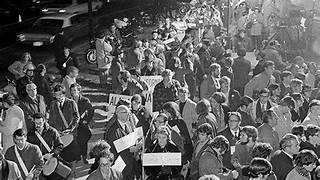n
In 1969, the United States was embroiled in the Vietnam War, a deeply divisive conflict that sparked widespread protests and demonstrations across the nation. One of the most significant events of that year was the March Against Death, a powerful and poignant protest held in Washington, D.C., that captured the growing public opposition to the war and demanded an end to the senseless loss of lives. The March Against Death took place on November 13-15, 1969, and was organized by the Vietnam Moratorium Committee, a coalition of anti-war groups. The march was a response to the staggering number of casualties in the war and aimed to honor the soldiers who had lost their lives while highlighting the devastating impact of the conflict on American society. Over the course of the three-day march, thousands of protesters, including war veterans, students, and concerned citizens, walked silently through the streets of Washington, D.C. Each participant carried a placard with the name of a soldier who had been killed in Vietnam, creating a visually striking and emotionally charged display of the human cost of war. The March Against Death was a solemn and somber affair, with participants marching in single file, their faces reflecting grief, anger, and determination. Along the route, they passed by the White House, the Capitol, and the Pentagon, symbolically holding the government accountable for the lives lost in the war. The march culminated in a powerful and emotional ceremony at the National Mall, where the names of over 15,000 soldiers who had died in Vietnam were read aloud. The reading of the names continued throughout the night and into the following day, symbolizing the endless procession of lives lost in the war. It was a deeply moving and cathartic moment for many participants, as they confronted the staggering human toll of the conflict. The March Against Death had a profound impact on the anti-war movement and the public perception of the Vietnam War. It brought the war's human cost into sharp focus and forced Americans to confront the reality of the lives lost and the families shattered by the conflict. The march also served as a platform for veterans to express their opposition to the war and demand accountability from the government. The March Against Death was a turning point in the anti-war movement, galvanizing public opinion and contributing to the growing pressure on the government to end the war. It demonstrated the power of peaceful protest and collective action in effecting change and shaping public discourse. The impact of the March Against Death extended beyond the immediate moment. It inspired similar protests and demonstrations across the country and helped to mobilize a broader movement against the war. The public outcry against the Vietnam War continued to grow, eventually leading to the withdrawal of American troops and the eventual end of the conflict in 1975. The March Against Death remains a significant event in U.S. history, representing the power of collective action and the resilience of the American people in the face of a deeply divisive and controversial war. It stands as a reminder of the importance of standing up for what one believes in and demanding accountability from those in power. The march's legacy continues to inspire and inform ongoing movements for peace, justice, and social change.
